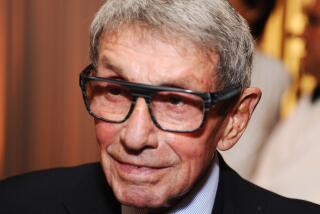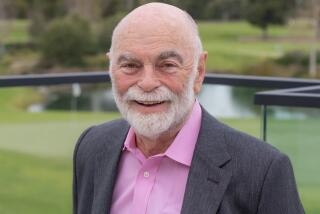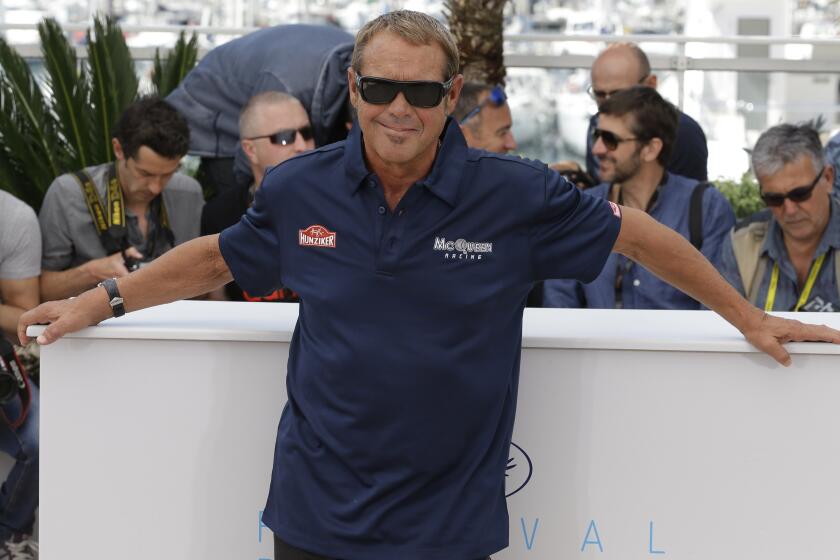From the archives: Veteran Actor Vincent Price Dies at 82
Vincent Price, art historian and collector, gourmet cook, author, raconteur and multifaceted “Merchant of Menace” best known for his blood-curdling roles in horror films, died Monday night at his home in the Hollywood Hills. He was 82.
The veteran actor succumbed to lung cancer after a long battle with the disease, according to his personal assistant, Reg Williams.
Tall, graceful, worldly and well-spoken (he was educated at Yale and the University of London), Price became a popular lecturer on college campuses and guest on television talk shows, passing along such non-bloodthirsty tidbits as how to cook fish in a dishwasher.
But unlike most actors who gained fame in their younger years, Price retained box office appeal well into in his 70s, when he was still reaching into new entertainment venues, performing briefly in Michael Jackson’s music video “Thriller” and as the voice of the rat in Disney’s animated “The Great Mouse Detective.”
Although something of a 20th-Century Renaissance man, Price was remembered best by mass audiences as a slimy, horrifying ghoul.
“I think I’ve made 110 pictures and only 20 of them have been in the thriller category,” he said in 1986. “But that is what people remember. I guess it all started with ‘The House of Wax,’ one of the greatest successes in that field. I’ve been stuck with it ever since.”
The “House of Wax” (1953) gave the genre and Price an extra boost because it introduced the short-lived technique of three-dimensional movies. As the evil proprietor of a wax museum who chose to coat real bodies with wax—after he had killed them—the actor literally reached out to audiences wearing special viewing glasses for the three-dimensional effect.
Price’s other horror films included a series based on the writings of Edgar Allen Poe (whom Price considered the greatest American author)—”The Raven,” “The Pit and the Pendulum,” “The House of Usher,” “Tales of Terror,” “The Cask of Amontillado,” “The Masque of the Red Death” and “The Tell-Tale Heart.”
Price was still a force in film at age 80, when he performed a typical role as the kindly creator of a fantasy teen-ager, Edward Scissorhands. His character died before he had completed the youth’s hands, leaving dangerous metal scissors at the ends of his wrists.
Price frequently borrowed Poe’s climactic line from “The Raven” when asked all too frequently if he objected to being type-cast as a villain:
“Nevermore.”
“It’s the fact that you are type-cast that gives you your fame,” he told The Times in 1985. “I’m not the least bit disappointed that I’m remembered primarily for my horror roles.
“We were all very serious about those pictures,” he said of his colleagues in the fright fraternity. “Boris (Karloff), Basil (Rathbone), Peter (Lorre) and I knew we weren’t doing ‘Hamlet,’ but we also thought we were doing marvelous entertainment.”
“I’ve just done everything,” he told another questioner, “but I feel that I’ve had a good life. I haven’t been as ‘successful’ as some people, but I’ve certainly had more fun.”
Although his distinguished speech caused many to think Price was a native of Britain, he was born in St. Louis, the youngest of four children of well-to-do Margaret and Vincent Leonard Price. His grandfather had made a fortune in baking powder, but lost it in the economic crash of 1893. His father was able to save and make a success of one subsidiary, the National Candy Co., which provided sweets for the nation’s five-and-dime stores.
Price decided as a child that he wanted to be an actor, but he had better luck grounding himself in food and art. In his acting debut--as an angel in the school Christmas play—he forgot his lines.
He learned his culinary skills from his mother—”a one-woman home economics class. We learned about cooking. We learned about sewing. I still mend suits and I do it very well.”
As for the fine arts, at 12 he bought his first piece, a Rembrandt etching, for $37.50—paying “$5 down and 50 cents a month for the rest of my natural life.”
Developing his early talents, Price went on to write a cookbook, “A Treasury of Great Recipes,” and instruct Johnny Carson and the nation watching “The Tonight Show” on how to prepare fish in a dishwasher:
“Tightly wrap trout in foil with lemon, wine, parsley, salt and pepper. Put it through the whole cycle. No soap!”
He also wrote art books, such as “I Like What I Know” and “Treasury of American Art;” a book on monsters with his son, Barrett, and one about his dog called “Book of Joe.”
A well-received lecture at East Los Angeles College in Monterey Park led him late in life to donate the art and then endow the Vincent Price Gallery at the community college. He normally was booked a year in advance for about 60 lectures a season on food, art and Hollywood monsters.
He also found time to act, although it took him a while to get started.
Graduating from Yale University (where he majored in art history and English) into the Great Depression in 1933, Price was unable to find work as an actor, so he took the only job offered—as an apprentice teacher at the Riverdale Country Day School in New York. He drove a bus, coached soccer and supervised a dormitory in addition to teaching art history.
Financed by a $900 gift from his parents, Price went to England, seeking a master’s degree in art history at the University of London. But he soon was cutting classes in favor of bit parts in London’s West End theaters.
Within a couple of months, he auditioned successfully for the lead part of Albert to Helen Hayes’ Queen Victoria in a play about the royal couple, “Victoria Regina.”
“To my amazement, the play was a hit,” he wrote years later in Art & Antique magazine. “The classes I missed became faraway guilts.”
Price dropped out as a student and went to Broadway with the play. The change in geography increased his salary from 5 pounds, or about $24 a week at that time, to $250 a week on Broadway.
After two years in the hit show, Price signed a contract with Universal Pictures. When no film roles materialized, he returned to legitimate theater. During his lifetime, Price appeared in more than 75 plays, including his one-man show devoted to the writings of Oscar Wilde, which he performed more than 800 times.
In 1937, Price joined Orson Welles’ famed Mercury Theater, with a role in “The Shoemaker’s Holiday.”
“Actually, Orson was just a kid at the time—only about 22 years old,” Price said years later. “But he was the finest director I ever worked for. He was really brilliant . . . inventive . . . a marvelous, marvelous director.”
Price’s roles for Welles included some of theater’s greatest villains—Fagin in “Oliver!” Captain Hook in “Peter Pan” and the devil in “Damn Yankees.”
He finally shifted to Hollywood in 1938, when he was 27, as a tractor inventor in “Service de Luxe,” a film that critics labeled “a pathetically unfunny farce.”
In 1939, Price began establishing himself in horror films, appearing with Rathbone and Karloff in “Tower of London.”
One of his favorites, “The Eve of St. Mark,” was made during World War II. He played a Southern soldier in what he described fondly as “one of the few good-guy roles.”
He later played a key dramatic part as an Egyptian architect in Cecil B. DeMille’s colossal “The Ten Commandments,” which required eight years to film and was released in 1956.
He also portrayed a series of fops and dandies in many films, of which the best known may have been Shelby Carpenter in the classic 1944 thriller “Laura.”
Price also dabbled in radio theater, portraying Simon Templar on “The Saint” (later done on television by Roger Moore). Television audiences may remember him as Egghead, archvillain of the television version of “Batman” in the 1960s, or the host of PBS’ “Mystery” series in the 1980s. He also appeared on more than 300 episodes of the television game show “Hollywood Squares” and once tied for the top prize on “$64,000 Question” when the subject was art.
During World War II, when there was little acting to do, Price and some friends opened a small art gallery in Beverly Hills, called The Little Gallery, and were awe-struck when actresses Katharine Hepburn and Greta Garbo appeared as customers.
Over several years, Price selected some 15,000 art pieces for Sears, Roebuck & Co. to sell to the working class.
“Art is everywhere,” he once said, “and where it isn’t, I don’t want to go.”
Price wrote an art column for a time, syndicated to more than 80 newspapers, and served as chairman of the U.S. Department of the Interior’s Indian Arts & Crafts Board. He was also on the UCLA Art Council and was an art juror for the Los Angeles County Museum of Art.
Among Price’s honors was the George Washington Carver Institute’s award for outstanding contributions to art, science, education and betterment of race relations.
Price painted only one canvas himself—a portrait of his mother, which he destroyed after her death.
“I am,” he said pragmatically, “an art lover, not an artist.”
Price was married three times: to actress Edith Barrett, mother of his son, Vincent Barrett Price; to costume designer Mary Grant, mother of his daughter, Mary Victoria, and to actress Coral Browne, who died in 1991.
As Price aged, he became the subject of frequent retrospectives of his films.
“You really feel ancient when they start showing retrospectives of your work,” quipped the typically unassuming actor. “That and when you’re in a wax museum. It all makes you feel as if you’ve been buried.”
And Price said that his history of horror roles may have taught him something about that consummate act.
“I’ll go on acting until I die,” he said. “They will have to bury me before I retire, and even then, my tombstone will read: ‘I’ll be back.’ ”
More to Read
Start your day right
Sign up for Essential California for the L.A. Times biggest news, features and recommendations in your inbox six days a week.
You may occasionally receive promotional content from the Los Angeles Times.







